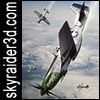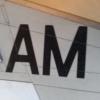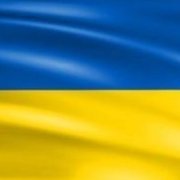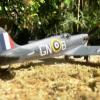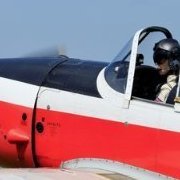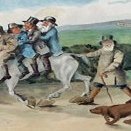Search the Community
Showing results for tags 'De Havilland'.
-
Here's my current WIP project, the famous "wooden wonder": the De Havilland Mosquito. This is actually my first British WW2 project since I started doing 3D some fifteen years ago! About time too, as I lived in the UK for the better part of a decade! I've started with the most common version, the FB Mk VI. The Mosquito served in no less than two dozen countries and about 60(!) pilots made ace on the Mosquito, so it's a nice and versatile subject! Some more images of its current state: Still some modelling left to do, but it's starting to look like a Mosquito! As per usual there were no "perfect" drawings available, so it's a combination of known dimensional data, scale plans, engineering drawings, manual drawings, DH fuselage lofting data generously supplied by Mark Gauntlett (many thanks Mark!), AAEE reports, NACA reports and hundreds of photographs. I.e. plenty of research! Mark's drawings are the most accurate around, by the way, and form the basis of this model, though especially on the tail, wing and engine nacelles I've deviated from them were necessary. My goal is to make this an absolutely accurate 3D Mosquito. The Mosquito will go well with the Junkers Ju 88 I made last year. These two aircraft are perfect adversaries and during the course of WW2 they fought eachother around the clock, over sea and over land, in all bomber, fighter and recce roles. Interestingly the battle between the Ju 88 and the Mosquito started even before the prototype was finished! On 3 October 1940 a well-aimed attack by a single Ju 88 flying at just 60 ft destroyed most of the jigs and killed 21 De Havilland staff, while injuring another 70. The prototype escaped major harm luckily, and as a sign of things to come, the Ju 88 was shot down by small arms fire... I should be rounding this up this month, so stay tuned!
- 34 replies
-
- 2
-

-
- de havilland
- mosquito
- (and 8 more)
-
Sources: http://www.marshmodels.com/main.asp?s=Aerotech http://www.ipmsdeutschland.de/news.html V.P.
- 1 reply
-
- 1/32
- de Havilland
- (and 4 more)
-
Airfix's 1/24 scale De Havilland Mosquito FB.VI has arrived into stock, just in time for Christmas! https://www.wonderlandmodels.com/products/airfix124-de-havilland-mosquito-fbvi/
- 1 reply
-
- 3
-

-
- new release
- airfix
- (and 8 more)
-
Hi Everyone, I've just completed a project to build 5 Chipmunks, in each of the liveries offered by Airfix over the years. Airfix have released a few more than I built, but the ones I've chosen not to build are duplicate schemes with ones that I have. The intention with this project was not to add too much detail or refinement, but to build them as Airfix intended. I did add instrument panels and harnesses though, although they are difficult to see through the canopy. I managed to keep my hands off the rivets until the last one, when I just had to refine them. I hope you like it. Cheers Tony
- 16 replies
-
- 33
-

-
- DHC
- De Havilland
-
(and 1 more)
Tagged with:
-
After the Hornet F. & F.3 (http://www.britmodeller.com/forums/index.php?/topic/234953190-148-dh103-hornet-f13-sea-hornet-nf21-by-trumpeter-f1-released-f3-nf21-box-arts/?p=1510384 ), Trumpeter is to release a 1/48th de Havilland DH.103 Sea Hornet NF.21 kit - ref.02895. Release is expected for late June 2015. So available in the best hobbyshops in July-August 2015. Source: http://new2.trumpeter-china.com/index.php?g=home&m=article&a=show&id=46&l=en Box art Source of inspiration Source: http://aviadejavu.ru/Images6/AE/AE03-5/13-1.jpg V.P.
- 9 replies
-
- 1/48
- de Havilland
-
(and 5 more)
Tagged with:
-
de Havilland Sea Vixen FAW.1. XJ482 There are only 2 FAW.1 Aircraft to survive, and this is the only one on public display, at The Norfolk and Suffolk Aviation Museum, Flixton. Pics mine.
-
Does anyone produce decals for these aircraft, preferably for 781 Squadron FAA, flying out of HMS Daedalus?
- 3 replies
-
- de Havilland
- Sea Devon
-
(and 2 more)
Tagged with:
-
Beeing uttlerly undiscerning I add another one to the pile... Enter Heritage Aviations de Havilland Comet racer: The D.H. 88 Comet kit is a 100% Polystyrene-free resin kit with vacuformed clear parts and white metal detail parts. Decals are included as well. All well packed in a sturdy box. The kit dates back to the previous owner of Heritage Aviation and thus is a bit older, which can be seen in the details and mold quality. Compared to newer resin kits this one looks to be "exciting". I purchased this kit some years ago but never picked myself up to start it (I shudder at the tought of the u/c assembly and the fuselage - see below). There are three seats included. Two were not 100% OK but one was very good and I recased it in resin (not shown). The lack of photoetch parts became unbearable to me at some time and I did new instrument panels in CorelDraw and had them etched by Peter Kormos (excellent guy! - see Tinyland.com). As said the castings are so-so. Some pin-holes and some larger ones... One of the biggest flaws is the fuselage which has very prominent steps from misaligned molds. I have the stron feeling that one side is longer than the other giving it a banana-like shape from above. At last I have made out a way to solve this in the years the kit rested in my stash. Wish me luck or better a broken leg so I can stay some weeks at home finishing all the started kits... ;-) Rene
- 21 replies
-
- 3
-

-
- Madness!!!
- de Havilland
-
(and 4 more)
Tagged with:
-
de Havilland Mosquito Mk.IV 1:32 Revell Prior to WWII there were specifications for a twin engined medium bomber which lead to the Manchester and the Halifax. There were also plans to use non strategic materials for aircraft production. Geoffrey de Havilland recognised this and the company embarked on a project to design such an aircraft. A design team under Eric Bishop moved to Sailsbury Hall to start on what would become the DH.98. Originally the design of the DH.98 was too radical for the Air Ministry. However with the outbreak of war they became more receptive, but also sceptical about an unarmed bomber as it was thought The Germans would produce faster fighters. They were also opposed to a two man crew as it was thought a third crew member was needed to reduce the workload on long flights. Finally in Early 1940 the RAF & The Air Ministry met with de Havilland to finalise the design and order an unarmed prototype to be built. The call at this stage was for a light bomber/reconnaissance aircraft powered by two Merlin 21 engines. This was to be followed in March 1940 with an initial contract under Specification B.1/50 for 50 aircraft. By June of 1940 the DH.98 had been named the Mosquito, although it was often called The Wooden Wonder as well. The aircraft would go one to be manufactured as a Bomber, Fighter-bomber, Fighter, Night Fighter and Reconnaissance aircraft. The would carry a wide variety of weapons including the 4000Lb cookie bomb, Rockets, torpedoes, and even the High Ball bouncing bomb. A grand total of 7781 aircraft would be built. Due to the wooden construction a great deal of the construction was carried out not by traditional aircraft factories, but by furniture companies. It is worthy to note that the prototype of this famous aircraft was saved and now can be seen at The de Havilland Heritage Centre at Sailsbury Hall, along with both a Fighter and Bomber version. The Kit Revells kit of the Mosquito in 1/32 scale represents a Mk.IV Bomber. This kit was first issued by Revell back in 1971. The moulds though seem to have held up fairly well looking at the sprues. The kit arrives at 6 sprues of light grey plastic, and one clear sprue. As a kit of this age would suggest such detail as there is on a wooden aircraft is mainly raised, though details such as the crew door are recessed. Construction starts with the cockpit. The instrument panel is completed, this also has a back part as it with be seen through the nose. The instruments are provided as a decal. Pilots figures are provided if needed, if not the seats have moulded in belts to paint. The whole cockpit area is fairly sparse on the detail front and some scratch building will improve things in this scale. Once the cockpit is complete the tail wheel assembly needs to be made up and attached to its bulkhead. These two sub-assemblies can then be attached into the main fuselage and this can be closed up. The tail cone can then be added. The next step is complete the two part main wings, remembering to include the large radiator fronts at this stage as well. The main wings can now be attached to the fuselage. The tailplanes and vertical fin are also constructed and added to the main fuselage. It is then onto the engine nacelles. A basic Merlin engine is constructed for the Port side as a panel can be left open if wanted to show this. For the other side the modeller will just attach the exhausts to the inside of that nacelle. The landing gear is constructed and attached to the underside of the wings. Once this is done the engine nacelles can be carefully fitted over the gear. The gear doors can then be fitted. To complete the model the propeller assemblies are made up and added, the canopy also needs completing and adding to the cockpit. Due to the limitations of the mouldings when the kit was made the main canopy is in thee parts. However the main seam is down a panel line with a large clear insert in the middle. Canopy The canopy is clear but a little thick which shows the age of the kit. Decals Decals are provided for two aircraft. They are printed in Italy for Revell and up to the now usual standard. They are in register and colour density looks good. No.627 Sqn RAF, Woodhall Spa, June 1944 (With D-Day stripes) No.105 Sqn RAF, Marham, England, December 1942 Conclusion It maybe an older kit but its the only game in town for 1.32 Mosquito. Despite its age it should make up to be a good looking model. recommended. Revell model kits are available from all good toy and model retailers. For further information visit
- 13 replies
-
- 3
-

-
- de Havilland
- Mosquito
-
(and 1 more)
Tagged with:
-
After quite a few months' hiatus I'm back modelling in two GBs, but my first build went horribly, recyclable-y wrong in the Mosquito GB. Time to take a deep breath and do my best on two more basic jobs... results here. No aftermarket stuff, just the two recent reissues of this vintage kit. After what I thought was some rather smart work on them, I had to cut the heads off the 'interiors' as they were keeping the canopies off the fuselage! Oh well... that was the only snag, but it's still too cold for spraying and I had to put about 5 layers of Klear on 'Black Magic' in order to get any lustre! I really enjoyed doing them and researching a bit more on the Comet. In fact now these are going to be the first of seven - decals for 'Grosvenor House' led to more sets for 'Boomerang', 'The Orphan', 'The Burberry' and 'Australian Anniversary'. Should make for a colourful shelf among all the camo! Hope you like them!
- 15 replies
-
- 4
-

-
Pics by me from the de Havilland Heritage Centre. TA634 DH98 Mosquito TT.35 Julien
- 2 replies
-
- de Havilland
- Mosquito
-
(and 1 more)
Tagged with:
-
de Havilland Sea Venom, pics thanks to Nigel Heath of Sea Venom FAW.22 - WW145 on display at National Museum of Flight, East Fortune, Scotland.
-
de Havilland DH.87 Hornet Moth, pics thanks to Mark Mills. G-AHBL G-ADKC G-ADND
-
- de Havilland
- DH.87
-
(and 1 more)
Tagged with:
-
I have had a bit of a break from modelling, but thought It was time to have a go at another kit; I have two kits that I bought last year but haven't found time to start yet. This time, I will be building the De Havilland Vampire T.11 from Airfix: I have read good things about this kit, and seen some great results on forums so far. I'm looking forward to building it. The kit has 3 main sprues and a clear sprue: The instructions and decal sheet: As with my other builds, I will be doing things by hand, all brush-painted and finished manually. I will be making the kit in the Vampire Preservation Group colours; the yellow training scheme as on the box artwork. Such a great-looking aircraft, I hope I can see it someday at an airshow. OK, on with the build...first stage is the cockpit...
-
de Havilland DH.90 Dragonfly, pics thanks to Mark Mills.
-
- de Havilland
- DH.90
-
(and 1 more)
Tagged with:
-
de Havilland DH.89 Dragon Rapide, pics thanks to Mark Mills. G-AEML G-AGJG G-AGSH G-AGTM G-AIDL G-AIYR
-
- 2
-

-
- de Havilland
- DH.89
-
(and 2 more)
Tagged with:
-
Hi all, Well after waiting for a week and a half I found out where my kit that was in the post had got to... In the PO just down the road. Postie hadn't put through a red slip saying there was a package waiting... Anyway, I finished my DH.82A build now onto something even more classic, DH.60G, this kit is a CBK released decades ago before NOVO got their hands on it and produced it. Made in the USSR... Means this individual kit is several years older than me! I've found it to be a very relaxing build, nothing complex at all. Scratch built interior using plasticard and some old seats from the airfix bedford. Not too pretty in there, however, there will be a large wing right over the forward cockpit anyway. Frustratingly, I didn't varnish the decals before trying to aplly them to the upper and lower wings. So they simply disintegrated and now I have to print my own tomorrow or paint them. More to follow Ben
- 11 replies
-
I am planning a DH9a to DH 16 project. So far I have found good photographs on the net which explain a lot but only one basic drawing which appears to be taken from the Putnam publication. I am trying to understand how the original was converted, there is mention of a new 'wider' fuselage, the photographs appear to show the same width at the undercarriage but perhaps the taper starting further back. Is there a good published drawing of this aircraft which show the changes to the fuselage anound the cabin and engine? All help gratefully received .
- 8 replies
-
- airliner
- De Havilland
-
(and 2 more)
Tagged with:
-
de Havilland DH.85 Leopard Moth, pics by Mark Mills. G-AIYS G-ACUS G-ACOJ
-
- de Havilland
- DH.85
-
(and 1 more)
Tagged with:
-
de Havilland DH.88 Comet. G-ACSS "Grosvenor House" Pics thanks to Mark Mills.
-
- 7
-

-
- de Havilland
- DH.88
-
(and 1 more)
Tagged with:
-
I originally posted this in the Aviation Art section, but I'd really like some feedback as I go along so please treat this as any other work-in-progress build Here's my current project, a digital 3D model of the famous "wooden wonder": the De Havilland Mosquito. This is actually my first British WW2 project since I started doing 3D some fifteen years ago! About time too, as I lived in the UK for the better part of a decade! I've started with the most common version, the FB Mk VI. The Mosquito served in no less than two dozen countries and about 60(!) pilots made ace on the Mosquito, so it's a nice and versatile subject! Some more images of its current state: Still some modelling left to do, but it's starting to look like a Mosquito! As per usual there were no "perfect" drawings available, so it's a combination of known dimensional data, scale plans, engineering drawings, manual drawings, DH fuselage lofting data generously supplied by Mark Gauntlett (many thanks Mark!), AAEE reports, NACA reports and hundreds of photographs. I.e. plenty of research! Mark's drawings are the most accurate around, by the way, and form the basis of this model, though especially on the tail, wing and engine nacelles I've deviated from them were necessary. My goal is to make this an absolutely accurate 3D Mosquito. The Mosquito will go well with the Junkers Ju 88 I made last year. These two aircraft are perfect adversaries and during the course of WW2 they fought eachother around the clock, over sea and over land, in all bomber, fighter and recce roles. Interestingly the battle between the Ju 88 and the Mosquito started even before the prototype was finished! On 3 October 1940 a well-aimed attack by a single Ju 88 flying at just 60 ft destroyed most of the jigs and killed 21 De Havilland staff, while injuring another 70. The prototype escaped major harm luckily, and as a sign of things to come, the Ju 88 was shot down by small arms fire... I should be rounding this up this month, so stay tuned!
- 37 replies
-
- 4
-

-
- De Havilland
- Mosquito
-
(and 8 more)
Tagged with:
-
Mosquito Wheels (5 types) 1:48 Ultracast Ultracast are a well-known Canadian aftermarket company that produce top-quality resin, as well as stocking a range of items from a number of other companies. This month sees them release a gaggle of resin replacement wheels for pretty much all 1:48 De Havilland Mosquitoes, with a variety of tread and hub patterns that should cater for most needs. Casting is first rate, and detail is very crisp indeed, with only a small casting gate to cut through to liberate the wheels from their blocks, which is situated on the very slightly bulged and flattened weighted bottom. A pair of triangular support "wings" are there to assist with casting and the easy removal of bubbles, and there is a little bit of clean-up needed where this intersects the tread pattern. The five types are as follows: Spoked wheels, block tread Spoked wheels, diamond tread Standard wheels, Australian Z-block tread Standard wheels, block tread Standard wheels, diamond tread Tread patterns are very well done, and all but the Australian tyres have Goodyear logos, plus tyre data on all sets. The spoked hubs are heavily cut-out to give the illusion of depth, and they even have tiny valve cut-outs with an almost invisible valve cap projecting from the rim. Some very good casting, to be sure! Conclusion These sets give the Mosquito modeller a great way to both improve the look of their model, in the Revell kit's case do something about the over-large wheels, and add a little individualism to the finished model. Quality is very good, and once the casting block has been removed they are a drop-in replacement for the kit parts. Highly recommended. Review sample courtesy of
-
De Havilland Venom NF.2 1:72 Czech Master Resin The Vampire was infamously characterised by its unorthodox twin boom layout. Being the second jet fighter to enter into RAF service after the Meteor, it set several records early in its existence and went on to serve in no less than 31 air forces. The Venom was a natural evolution utilising a thinner wing and more powerful engine to increase performance. There were two basic configurations, the single seater being a fighter bomber, where as the two seat machines had a cockpit layout based on that of the proven Mosquito providing all weather intercept capability. The radar operator sat slightly rear wards and to the right of the pilot with the radar set in front of him. The side-by-side arrangement was popular with crews as it offered good team spirit and the ability to still communicate in the event of an intercom failure. The first two seat variant to enter service was the NF.2 in 1953, however structural weaknesses in the wings near the tail booms led to several crashes in 1954. After a temporary grounding, service resumed with restrictions until the issues could be resolved. The NF.2a followed and featured several refinements including a clamshell canopy offering improved visibility and redesigned tail section to reduce buffeting at high speed. The final two seat variant was the NF.3 which entered service with 141 and 23 Sqn based at RAF Coltishall in the summer of 1955. Because at this stage the RAF had chosen the Javelin as the replacement all weather fighter, improvements to the NF.3 were limited, the main benefits being an improved Ghost 104 engine, APS-57 Airborne Intercept radar and radar-ranged gunnery. The performance of the later Venoms was superb, practice intercepts on Canberra’s flying at 550mph and over 40,000ft were achieved. Armament was a four pack of 20mm cannon in the belly. By the end of 1957, Javelins had replaced Venoms as front line aircraft. Incredibly, Venoms continued in military service until 1983 with the Swiss Air Force, one of 6 foreign operators of the aircraft. The Kit The latest in the Vampire / Venom series from CMR is the NF.3. The lit comes in the usual sturdy white box with simple but striking side profile image of the aircraft on the front. Inside, you find a full resin kit of 55 parts supplemented by two sheets of etch, two vac formed canopies and a paint mask for the canopy. The instruction pack has 6 pages of b&w photographs of the aircraft both in full and close up to aid your build. The polythene bags housing the delicate resin parts are sealed into small compartments to reduce the risk of damage. If you’ve built any of these before, CMR have recently started to supply the wings with the intakes already formed in place. Assembly starts with the cockpit interior. Having built the NF.2 a few months ago, this goes together fairly easily and uses a good mix of coloured etch and fine resin components to create a superbly detailed interior. The detail really stands out when using a wash. The nose wheel bay requires a thin flash of resin removing and the bay fits to the inside of the fuselage under the cockpit. A small amount of filler may be required after fitting this to seal any gaps. The assembled cockpit is glued between the two fuselage halves, not before you’ve added a weight. The only real challenge that I’ve come across with these kits is dealing with the seam line down the centre after joining the fuselage up. There is some flash along the seam mating edges that requires sanding off. I’ve had to use filler on both of my previous builds to eliminate the seam, however that might say more about my skill than the kit ! Obviously, being a resin kit, you don’t have location pins, nor can you use Liquid Poly type glue. I tend to hold the two halves together with thin strips of masking tape then run Super Glue along the seam. Surface detail is beautifully formed with very reserved recessed panel lines. Using a modelling knife works well to restore the lines across the filled seams, which I usually do at the priming stage later on. With the fuselage assembled, the wings are fitted next. There is some flash around the wing tip tanks and leading edges, however this sands off with ease. There is some thick resin mould residue that needs to be cut away from the wing roots to allow the wings to mate to the fuselage. I previously used a modelling knife to do this by repetitively scoring the material until it easily snapped off. As with the fuselage, surface detail is superb, but the detail in the main wheel bays and flaps is where you really see the benefit of using resin. They are incredibly detailed and well formed without adding any extra parts. The leading edge intakes each have two etch splitters vertically positioned giving excellent scale thickness. Etch is also used to replicate the wing fences. Tail booms next. On the previous two builds, fitting these was very straight forwards, getting them aligned didn’t present any issues. There's some small amounts of flashflash that will need removing from the mould seams which it's better to do before fitting. With the basic airframe complete, attention turned to the detail, primarily the flaps, undercarriage and various sticky out bits. The undercarriage legs are supplied in a different type of resin that is stronger to prevent them from warping under the weight. I’d recommend fitting the flaps after painting if you are intending to have them lowered because they are quite fragile. Handling the u/c and flaps is quite a fiddly job due to the small size of the parts so don’t try to rush these steps and patience will reward ! The canopy is beautifully thin and surprisingly strong. The moulding captures the slightly blown profile either side of the centre frame which I presume was to increase head height. If you’ve never used a vac canopy before, a great tip is to fill it with blue-tac before cutting from the sheet to retain its rigidity as it comes away. Rather than trying to cut in one go, score the cutting line lightly and repeatedly with a new blade until you break through for best results. Whilst the canopy and wind screen come moulded as one, using the new blade is easy enough to separate them if you want the canopy open. A second canopy is included in case you make any mistakes cutting your first one....as I usually do! When it comes to painting, masks are already supplied pre-cut in the pack. The decals For such a small kit, you get two full sheets of decals, the first with the 4 marking options, the second with over 80 stencils. The print on both sheets is in superb register and very fine. If they are like the ones on the NF.2, they are quite thin so should be handled carefully on application. The schemes included, all wearing the dark green, dark sea grey over medium sea grey are: WX853 of 23 Sqn RAF Coltishall, 1955 WX914 of 89 Sqn RAF Stradishall, 1956 WX849 of 151 Sqn RAF Leuchars, 1955 WX796 of 141 Sqn RAF Coltishall 1955 Conclusion This is a welcome addition to the range of Vampires and Venoms already offered by CMR. They aren’t for beginners nor do they aim to compete on price with main stream options. What you get is a premium kit with everything included to produce a stunningly detailed model without compromise. CMR kits can be purchased through distributors listed on their website linked on the logo below including Hannants in the UK. Review sample courtesy of
-
- de havilland
- venom
-
(and 2 more)
Tagged with:

